The Featured Creatures collection provides in-depth profiles of insects, nematodes, arachnids and other organisms relevant to Florida. These profiles are intended for the use of interested laypersons with some knowledge of biology as well as academic audiences.
Introduction
The fall webworm, Hyphantria cunea (Drury), is a pest of a number of ornamental trees and shrubs as well as of several agricultural crops. The larvae feed in huge nests and are able to completely defoliate trees and shrubs. Native to North America, this species has become an invasive pest throughout Europe and Asia, and therefore is well studied.
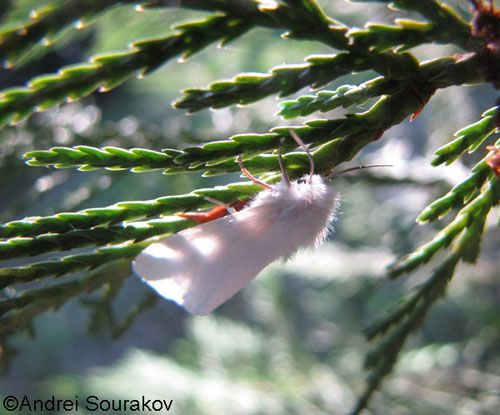
Synonymy
Hyphantria
liturata (Goeze, 1781)
punctatissima (Smith, 1797)
budea (Hübner, 1823)
textor (Harris, 1828)
mutans (Walker, 1856)
punctata (Fitch, 1857)
pallida (Packard, 1864)
candida (Walker, 1865)
suffusa (Strecker, 1900)
Distribution
The fall webworm originally occurred throughout North America to its northernmost limit in southern Canada. The nothern range limit for Hyphantria cunea occurs at the latitude of 50–55° (Morris 1963).
The fall webworm was introduced into Yugoslavia in the 1940s, and since then has invaded most of Europe. It now also inhabits parts of China and North Korea, again due to accidental introduction, and it is found in Japan.

Description and Life Cycle
The adult fall webworm moth is bright white, with a hairy body. In the southern part of its range, the moth is white with dark wing spots while in the northern part of its range it is nearly always pure white (MPG 2010) and was once thought to be a separate species from the southern populations. The gregarious larvae form large tents around the host plant. Currently, the taxonomic status of Hyphantria cunea as a single species remains intact. The variations in phenotypes of both adults and larvae (presence of dark markings on the wings in some populations and presence of populations with red-headed vs. dark-headed larvae) have caused speculation that more than one species might be involved. For example, in Japan, DNA barcoding studies have shown that two species might be occurring there sympatrically (Takeda 2005).
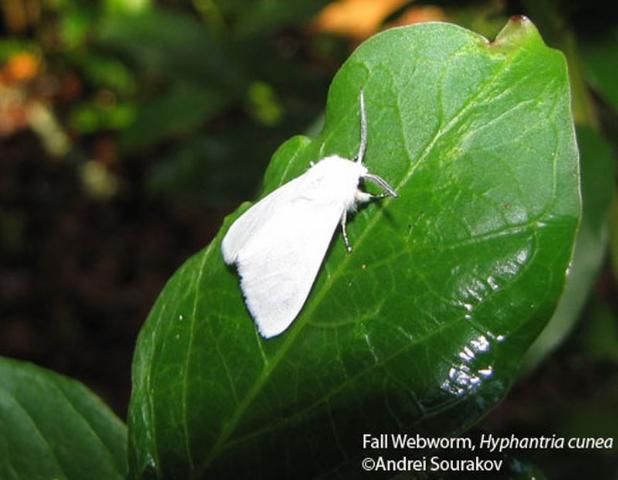
Credit: Andrei Sourakov, Florida Museum of Natural History, University of Florida
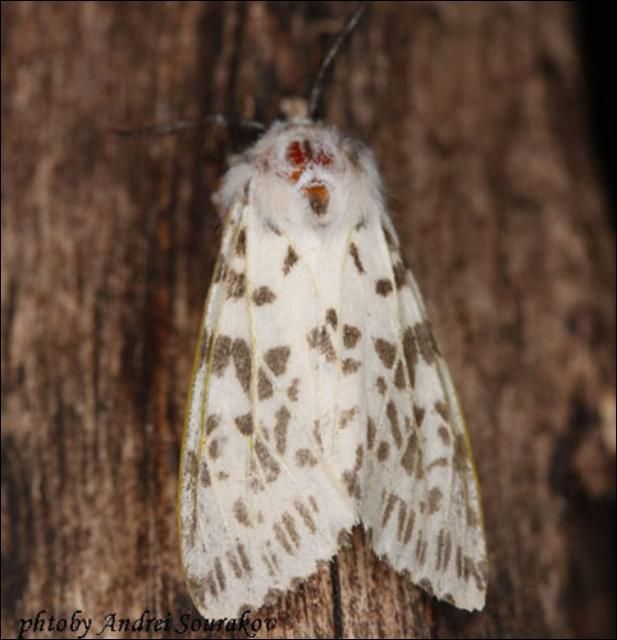
Credit: Lyle J. Buss, University of Florida
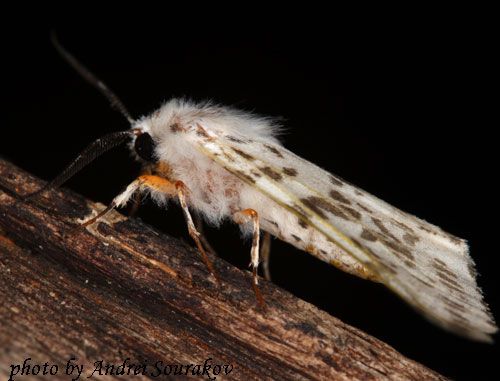
Like most moths, the fall webworm moths are nocturnal and are attracted to light. Adult moths have a wingspan of between 1.4–1.7 inches (35–42 mm). The bases of the front legs are orange or bright yellow.
The number of generations per year depends greatly on latitude. Southern populations may complete four generations in one year, while in the north the fall webworm completes only one life cycle. The univoltine chiefly black-headed and dark-bodied larvae tend to occur above 40° latitude, while the multivoltine cycles with green-bodied, red or black-headed larvae tend to be found in the southern part of the distribution area.
Adults emerge as early as March in the south, but do not fly until late spring or early summer in northern areas. Mostly, the adults appear from May to August and deposit their eggs.
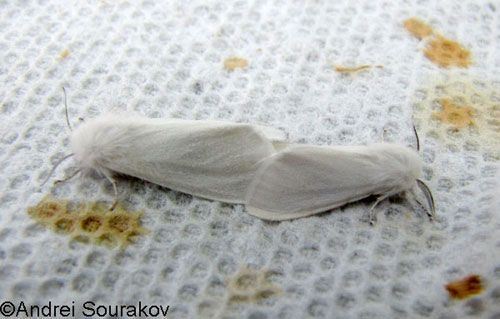
Eggs
The egg mass of Hyphantria cunea is almost iridescent green in color. The egg batch contains 400–1000 eggs. The eggs are usually deposited on the undersides of leaves in the spring, in a single (black-headed larva race) or double (red-headed larvae race) layer of several hundred eggs. The egg mass is lightly covered with scales from the female's abdomen.
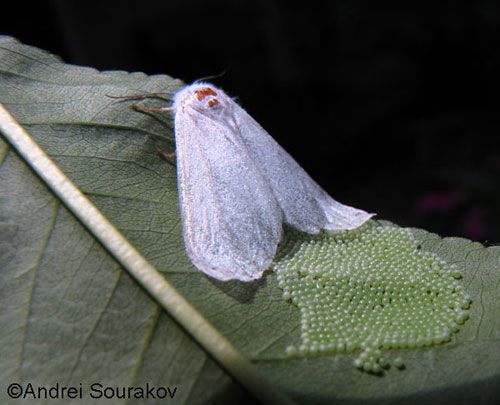
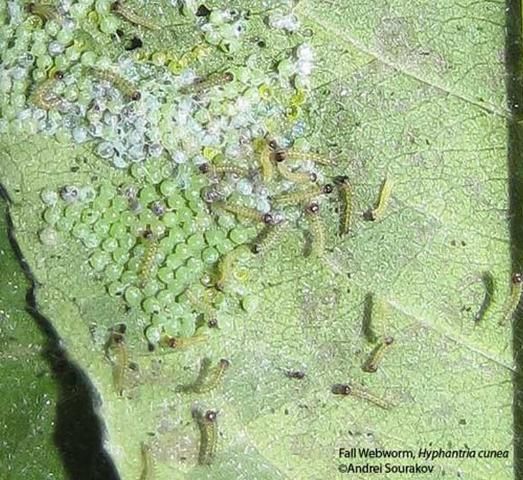
Credit: Andrei Sourakov, Florida Museum of Natural History, University of Florida
Larvae
In one to two weeks, the larvae hatch and immediately begin spinning their silk tent. The neonate caterpillars place the web over single leaves and feed by skeletonizing.
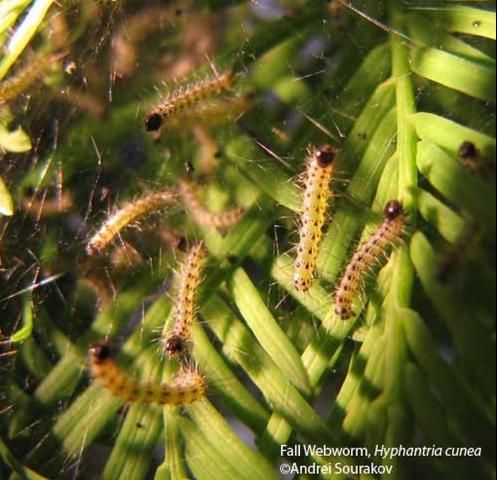
Credit: Andrei Sourakov, Florida Museum of Natural History, University of Florida
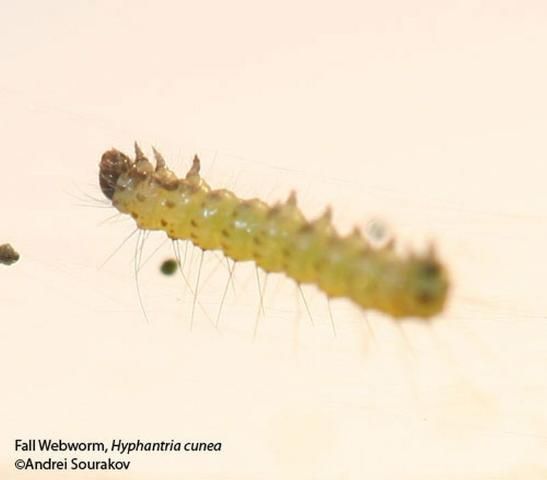
Credit: Andrei Sourakov, Florida Museum of Natural History, University of Florida
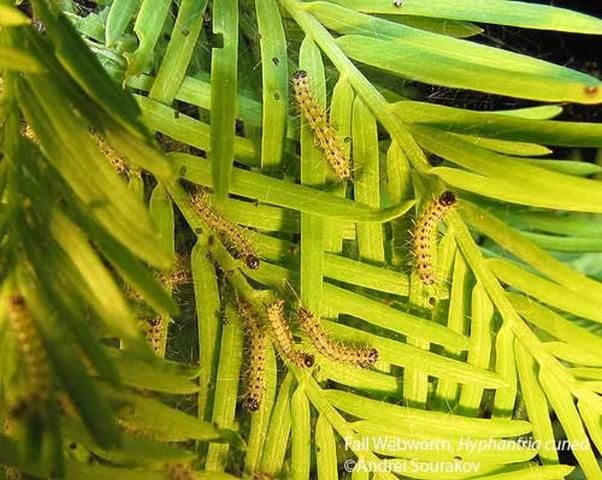
Credit: Andrei Sourakov, Florida Museum of Natural History, University of Florida
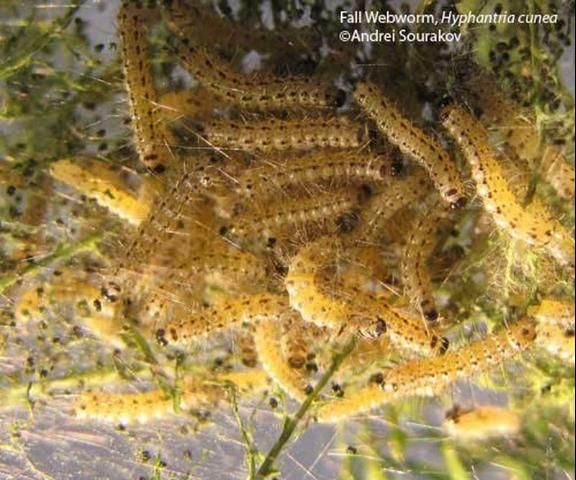
Credit: Andrei Sourakov, Florida Museum of Natural History, University of Florida
Mature larvae are hairy and either have a lime green body with black spots or can have darker color, especially in the later instars. The head capsules in some populations can be either red or black. In other populations, they are entirely black. The black-headed larvae are thought to be more prevalent in the northern climes, while the red-headed larvae are thought to be dominant in the southern climes. Some behavioral differences have been noted between different larval morphs. For instance, larvae of the red-headed morph stay inside the tent throughout the larval stage, while the black-headed morph leaves the tent in its fifth instar.
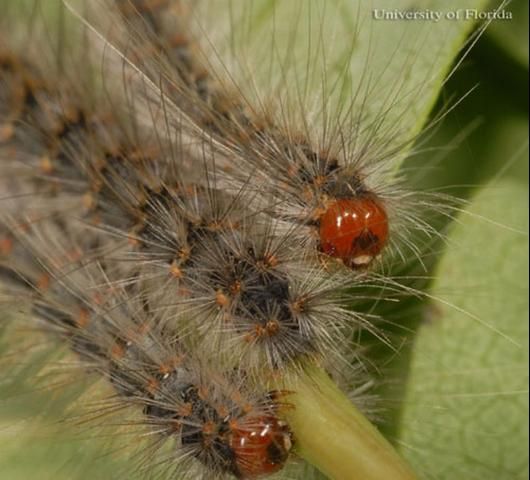
Credit: Lyle J. Buss, University of Florida
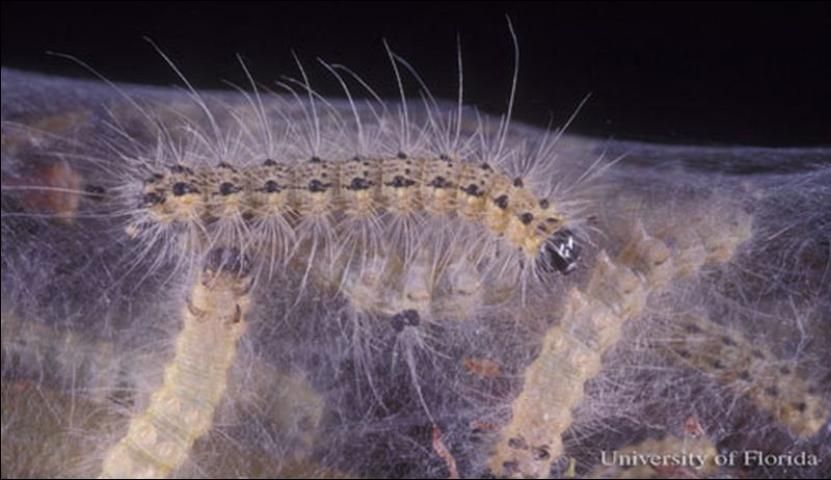
Credit: Lyle J. Buss, University of Florida
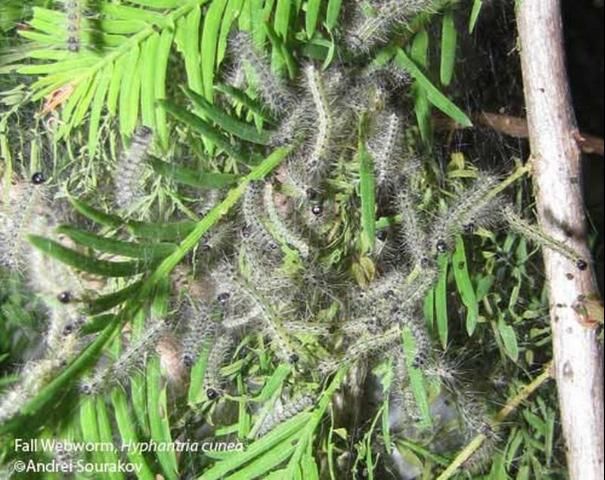
Credit: Andrei Sourakov, Florida Museum of Natural History, University of Florida
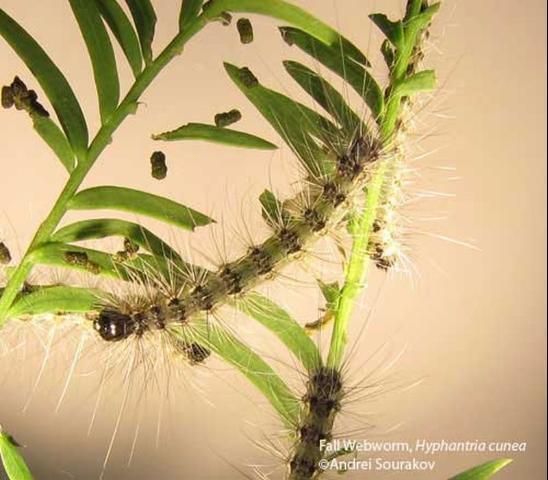
Credit: Andrei Sourakov, Florida Museum of Natural History, University of Florida
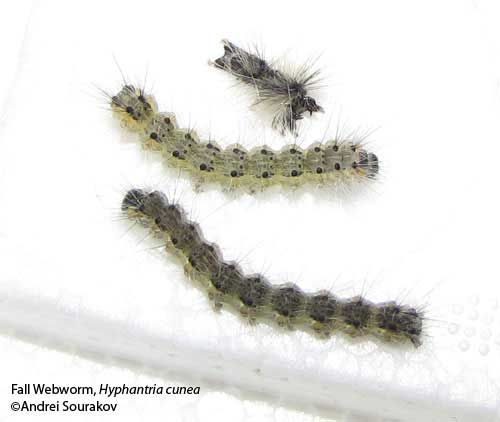
Credit: Andrei Sourakov, Florida Museum of Natural History, University of Florida
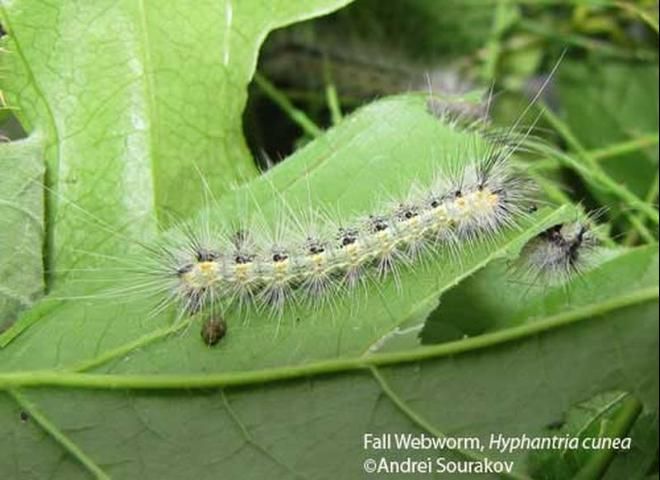
Credit: Andrei Sourakov, Florida Museum of Natural History, University of Florida
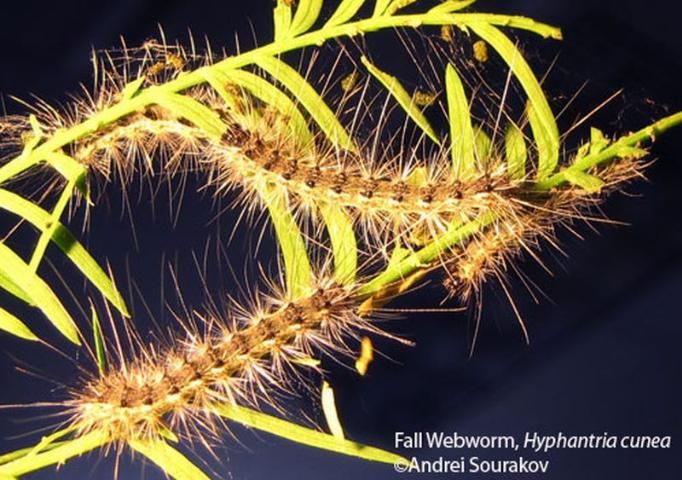
Credit: Andrei Sourakov, Florida Museum of Natural History, University of Florida
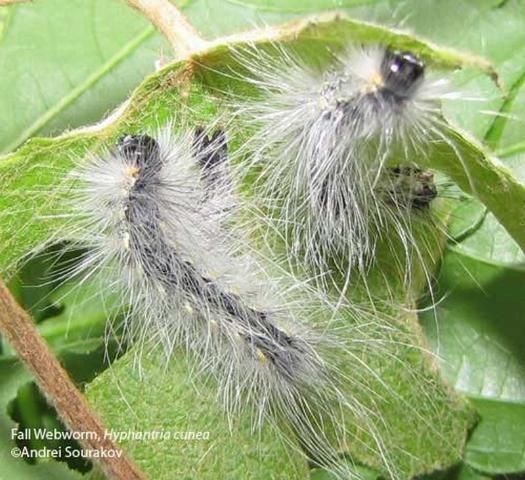
Credit: Andrei Sourakov, Florida Museum of Natural History, University of Florida
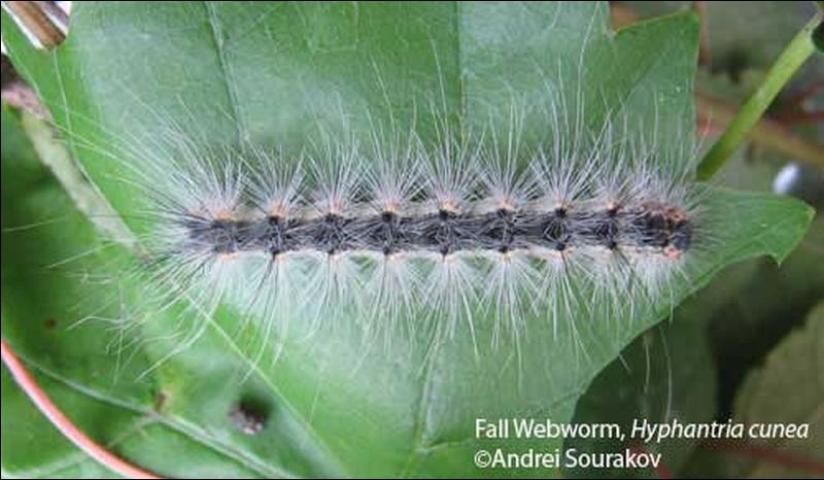
Credit: Andrei Sourakov, Florida Museum of Natural History, University of Florida
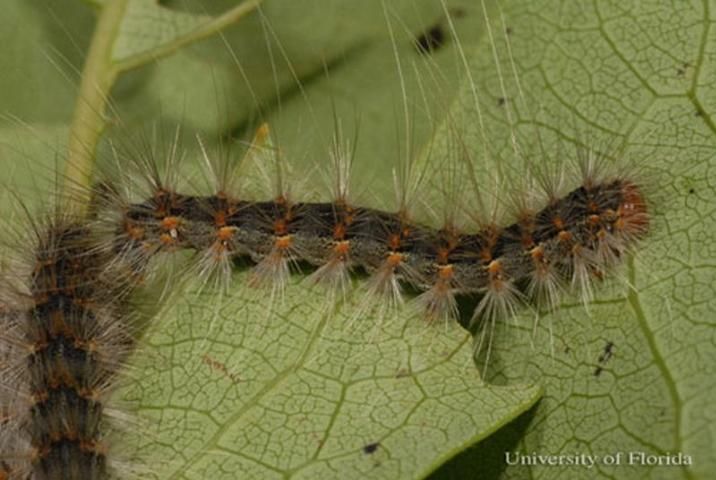
Credit: Lyle J. Buss, University of Florida
Pupae
Full-grown larvae leave the web to pupate in leaf litter or bark crevices. Fall webworms overwinter in the pupal stage. Pupation occurs in thin cocoons. The pupae are brown.
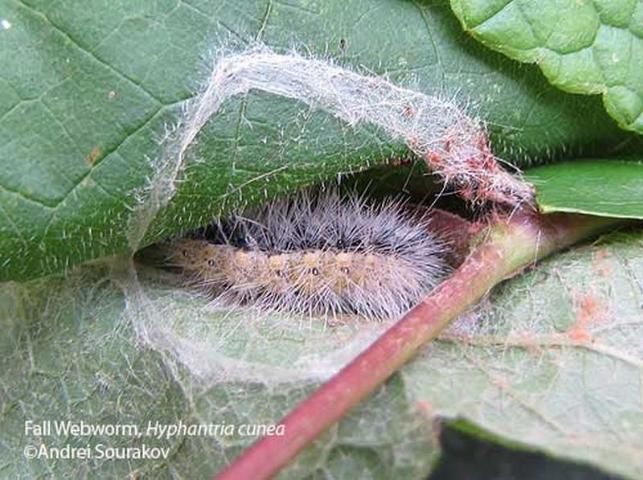
Credit: Andrei Sourakov, Florida Museum of Natural History, University of Florida
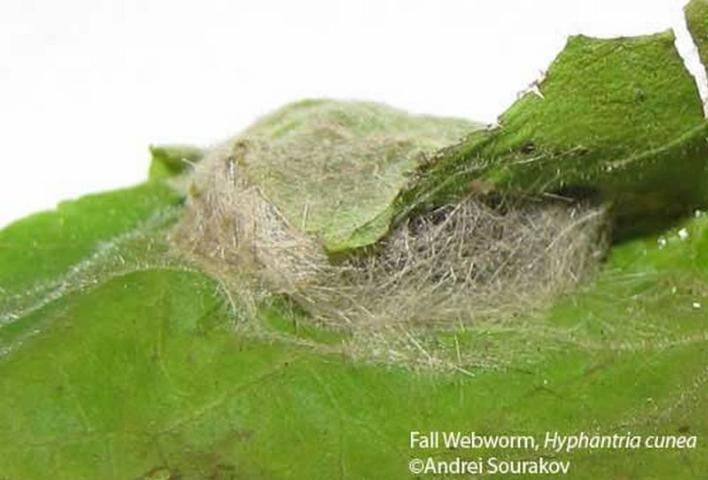
Credit: Andrei Sourakov, Florida Museum of Natural History, University of Florida
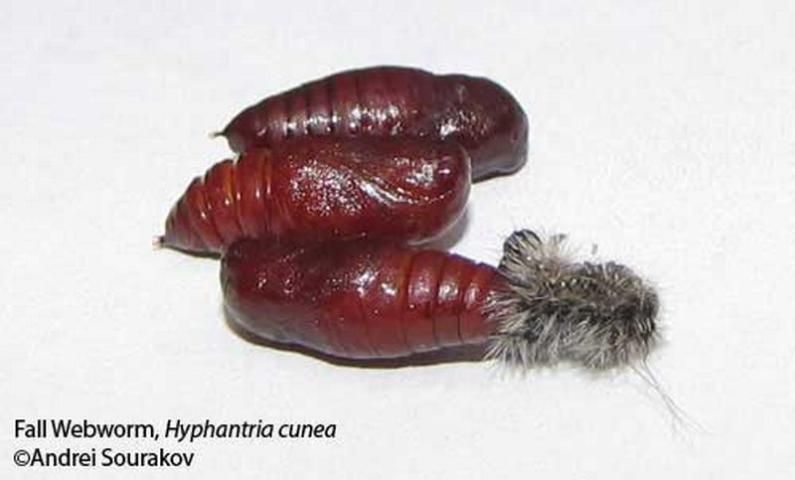
Credit: Andrei Sourakov, Florida Museum of Natural History, University of Florida
Hosts
Part of Hyphanea cunea's success as a species can be attributed to the fact that its larvae are consummate generalists, capable of developing on a wide range of host plants. Preferred host plants include hickory, pecan, walnut, elm, alder, willow, mulberry, oak, sweetgum, and poplar.
Host Plants Recorded in Florida (Heppner 2007, and personal observation)
Aceraceae: Acer spp.—A. negundo, A. rubrum, A. saccharinum, A. saccharophorum
Anacardiaceae: Cotinus coggygria
Anacardiaceae: Schinus terebinthifolius
Annonaceae: Asimina triloba
Aquifoliaceae: Ilex spp.—I. decidua, I. opaca
Berberidaceae: Berberis canadensis
Betulaceae: Alnus spp.; Betula spp.—B. alba, B. nigra, B. papyrifera; Carpinus caroliniana; Corylus americana; Ostrya virginiana
Bignoniaceae: Campsis radicans, Catalpa bignonioides, Catalpa speciosa
Buxaceae: Buxus spp.—B. sempervirens
Cannaceae: Canna spp.
Caprifoliaceae: Lonicera spp., Sambucus canadensis, Symphoricarpos albus, Virburnum spp.
Celastraceae: Euonymus atropurpureus
Chenopodiaceae: Chenopodium album, Spinacia oleracea
Comaceae: Cornus spp.—C. alternifolia, C. drummondii, C. florida
Compositae: Helianthus spp., Parthenium argentatum
Cupressaceae: Chamaecyperis thyoides, Cupressus spp., Juniperus virginiana, Taxodium distichum
Ebenaceae: Diospyros kaki, Diospyros virginiana
Ericaceae: Kalmia spp.
Ericaceae: Oxydendrum arboretum, Rhododendron spp.
Euphorbiaceae: Ricinus communis
Fagaceae: Castanea spp.—C. dentata, C. pumila; Fagus grandifolia; Quercus spp.—Q. alba, Q. coccinea, Q. phellos, Q.prinus, Q. rubra
Geraniaceae: Pelargonium spp., Geranium spp.
Gramineae: Zea mays
Hamamelidaceae: Hamamelis virginiana, Liquidambar styraciflua
Hippocastanaceae: Aesculus spp.—A. glabra, A. hippocastanum, A. octandra
Juglandaceae: Juglans spp.—J. californica, J. nigra, J. regia; Carya spp.—C. glabra, C. illinoinensis, C. laciniosa
Lauraceae: Sassafras albidium
Leguminaceae:
Leguminosae: Cercis canadensis; Gleditsia triacanthos; Gymnocladus dioica; Robinia pseudo-acacia; Trifolium spp.; Wisteria spp.—W. frutescens, W. sinensis
Malvaceae: Althaea rosea, Gossypium herbaceum, Hibiscus syriacus
Magnoliaceae: Liriodendron tulipifera, Magnolia spp.
Moraceae: Ficus carica, Maclura pomifera, Morus spp.—M. rubra
Naucleaceae: Cephalanthus occidenalis
Nyssaceae: Nyssa sylvatica
Oleaceae: Chionanthus virginicus; Fraxinus spp.—F. americana, F. excelsior; Jasminum spp., Ligustrum vulgare, Syringa spp.
Platanaceae: Platanus occidentalis
Pinaceae: Larix deciduas, Pinus spp.
Portulacaceae: Portulaca oleracea
Ranunculaceae: Clematis spp.
Rhamnaceae: Rhamnus alnifolia
Rosaceae: Amelanchier canadensis; Crataegus spp.; Cydonia oblonga; Malus spp.—M. angustifolia, M. coronaria, M. diversifolia, M. pumila; Prunus spp. - P. americana, P. avium, P. cerasus, P.domestica, P. ilicifolia, P. persica, P. serotina, P. communis; Pyrus communis; Rosa spp.; Rubus spp.—R. allegheniensis, R. idaeus var. strigosus; Spiraea spp.
Rutaceae: Citrus spp.—C. aurantiifolia, C. lemon, C. paradisi, C. sinensis; Zanthoxylum americanum
Salicaceae: Populus spp.—P. alba, P. balsamifera, P. deltoides, P. fremonti, P. nigra var. Italica, P. tremuloides; Salix spp.
Saxifragaceae: Ribes spp.—R. lacustre, R. sativum
Scrophulariaceae: Paulownia tomentosa
Simaroubaceae: Ailanthus altissima
Staphyleaceae: Staphylea trifolia
Taxaceae: Taxus spp.
Tiliaceae: Tilia spp.—T. americana, T. europaea
Ulmaceae: Celtis spp.—C. laevigata, C. occidentalis; Ulmus spp.—U. americana, U. rubra
Vitaceae: Parthenocissus quinquefolia, Vitis vulpina
Economic Importance
In the wild, within its native range, fall webworm does not usually damage the trees, since the defoliation occurs just before leaf drop. However, Hyphanea cunea is known to cause damage to ornamental trees and is also known as a pest of sericulture because of its preference for mulberry leaves (Franz 1961, Yang & Zhang 2007).
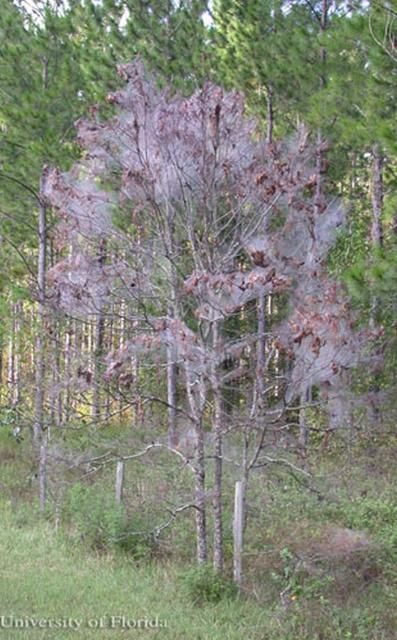
Credit: Lyle J. Buss, University of Florida
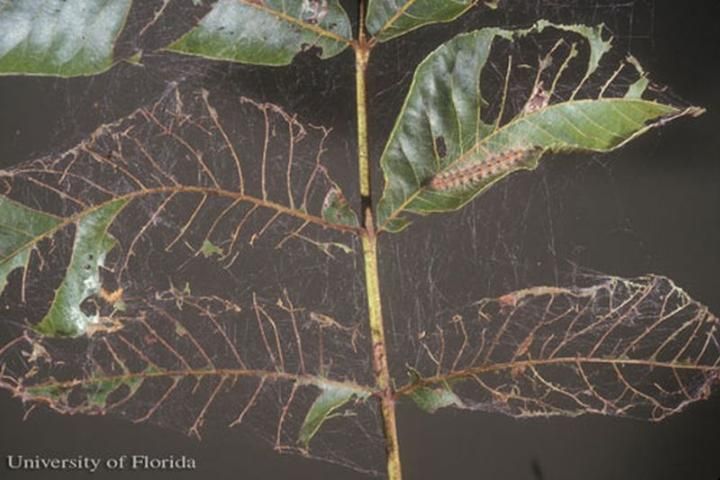
Credit: James Castner, University of Florida
A fall webworm tent normally encloses the foliage at the end of a branch. The caterpillars can build large silk tents that sometimes spread over several branches. At maturity, the larvae may reach one inch in length. Throughout their development, the caterpillars are able to make distinct jerking movements in unison if the nest is disturbed.
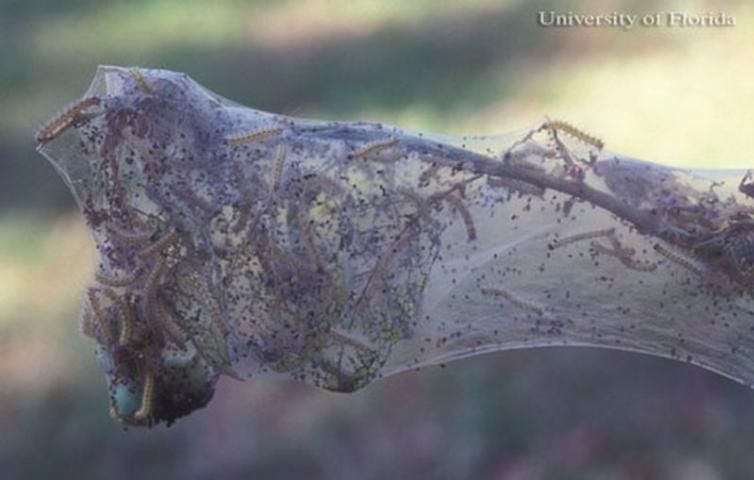
Credit: Lyle J. Buss, University of Florida
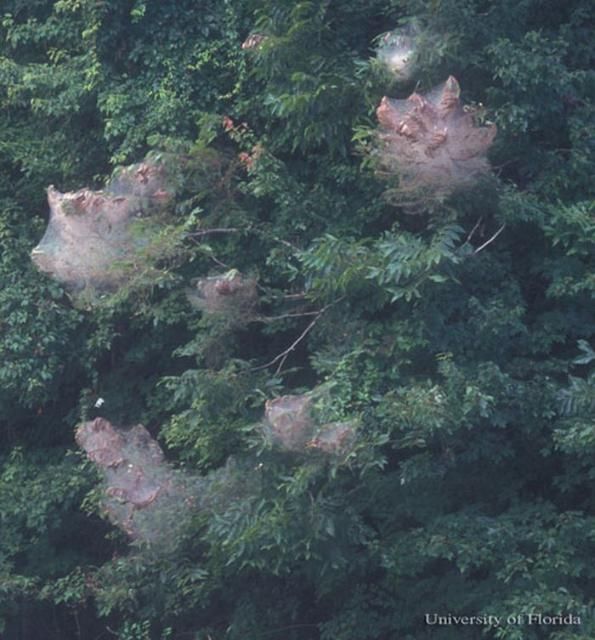
Credit: James Castner, University of Florida
Management
Biological Control
Parasitoids attacking Hyphantria cunea include
Diptera
Tachinidae: Exorista japonica Townsend, Lespesia frenchii (Williston), Mericia ampelus (Walker), Pales pavida Meigen, Zanillia libatrix Panz
Hymenoptera
Braconidae: Aleiodes malacosomatos Mason, Aleiodes sanctihyacinthi (Provancher), Apanteles diacrisiae Gahan, Apanteles hyphantriae Riley, Microplitis hyphantriae, Meteorus bakeri Cook and Davis, Meteorus hyphantriae Riley
Chalcididae: Brachymeria obscurata (Walker)
Eulophidae: Baryscapus esurus (Riley), Chouioia cunea Yang, Elachertus hyphantriae Crawford
Ichneumonidae: Campoplex validus Cress, Casinaria genuina (Norton), Casinaria limenitidis Howard, Coccygomimus disparis (Viereck), Coelichneumon navus (Say), Enicospilus glabratus Say, Hyposoter fugitivus (Say), Hyposoter rivalis (Cresson), Hyposoter pilosulus Provancher, Itoplectis inquisitor Say, Pimpla turionellae Linnaeus, Sinophorus validus (Cresson), Therion morio (Fabricius), Therion sassacus Vier, Vulgichneumon brevicinctor (Say)
Pteromalidae: Dibrachys cavus (Walker)
Torymidae: Monodontomerus minor (Ratzeburg)
Trichogrammatidae: Trichogramma dendrolimi Matsumura
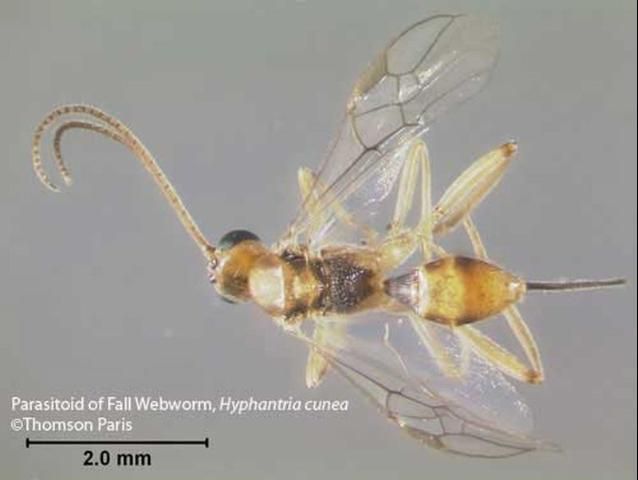
Credit: Thomson Paris, University of Florida
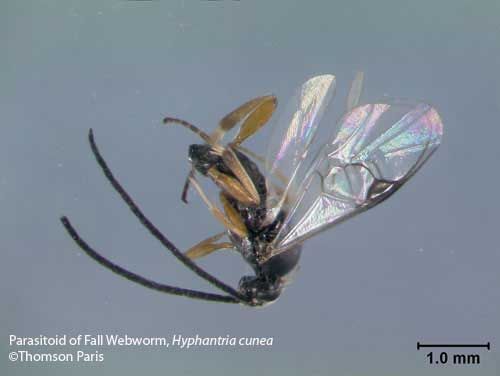
Credit: Thomson Paris, University of Florida
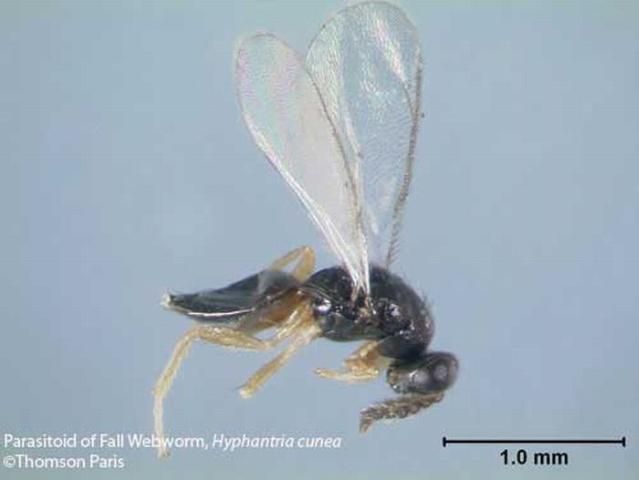
Credit: Thomson Paris, University of Florida
Chemical Control
Selected References
Franz JM. 1961. Biological control of pest insects in Europe. Annual Review of Entomology 6: 183–200.
Heppner JB. 2007. The Lepidoptera of Florida: Introduction and catalog, Part 1. Florida Department of Agriculture and Consumer Services, Division of Plant Industry. 670 pp.
Ito Y, Shibazaki A, Iwahashi O. 1969. Biology of Hyphantria cunea Drury (Lepidoptera:Arctiidae) in Japan. IX. Population Dynamics. Researches on Population Ecology (Kyoto) XI: 211–228.
Morris RF. 1963. Synonymy and color variation in the fall webworm, Hyphantria cunea Drury (Lepidoptera: Arctiidae). Canadian Entomologist 95: 1217–23.
(MPG) Moth Photographers Group. (2010). 930319 – 8140 – Hyphantria cunea – (Drury, 1773). North American Moth Photographers Group. http://mothphotographersgroup.msstate.edu/species.php?hodges=8140 (13 December 2010).
Takeda M. 2005. Differentiation in life cycle of sympatric populations of two forms of Hyphantria moth in central Missouri. Journal of Entomological Science 8: 211–218.
Wagner DL. 2005. Caterpillars of Eastern North America. Princeton University Press. Princeton, 512 pp.
Yang ZQ, Zhang YA. 2007. Researches on techniques for biocontrol of the fall webworm, Hyphantria cunea, a severe invasive insect pest to China. Chinese Bulletin of Entomology 44: 465–471.